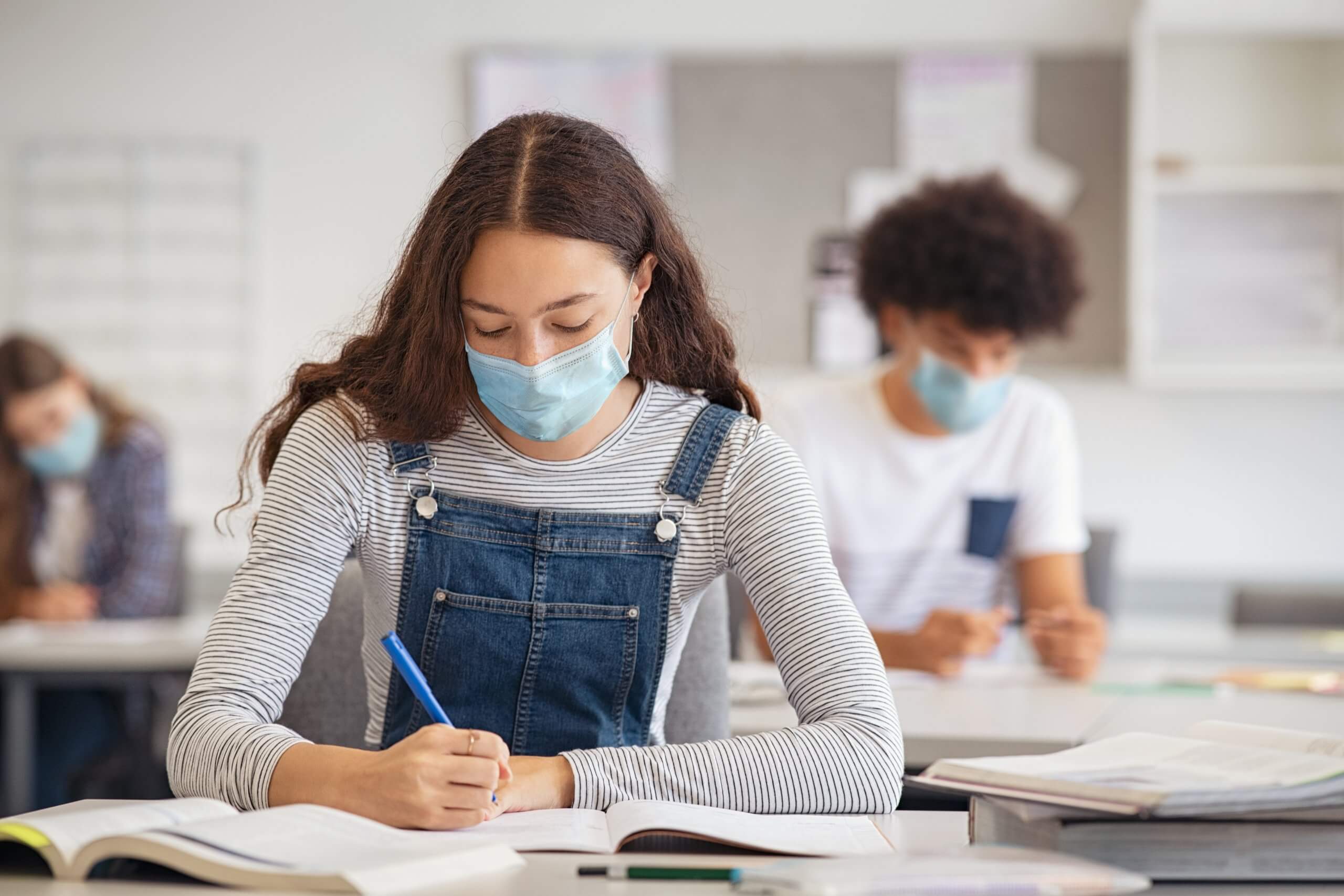The 2021 fall semester marks the start of the second full school year during the coronavirus pandemic. The upcoming academic year spans COVID’s two-year milestone next March. It begs the question—how did schools actually respond to COVID-19? Months later, we reflect on the measures school districts chose and improvements school buildings across America made to offer in-person instruction despite the virus.
Improving indoor air quality and building HVAC systems is a proven beneficial mitigation strategy against the coronavirus. (Of course, this is in addition to other mitigation practices such as hand washing, physical distancing, masks and more.) Focusing on school air quality responses … what IAQ solutions and control strategies did school districts consider? What options did schools actually pursue?
Analyzing School Air Quality Responses to COVID
In April 2021, the Center for Green Schools and the American Society of Heating, Refrigeration and Air-conditioning Engineers (ASHRAE) released a comprehensive report on how schools implemented IAQ solutions to respond to COVID-19. The study surveyed and analyzed school districts across the nation to learn what options were considered, prioritized and ultimately chosen.
About the Study
Many official organizations and recognized expert groups released school reopening guidance and recommendations in response to COVID-19. Researchers found six major IAQ strategies and solutions overlapped in the available guidance. These six options are:
Increased fresh air via mechanical ventilation …
- by increasing outdoor air supply
- through an air flushing process between room occupancy periods
Increased fresh air via natural ventilation by …
- opening windows
- placing fans in windows
Removing indoor air pollutants …
- via filtration with upgraded MERV filters—the ideal filter rating goal being MERV 13
- via purification through HEPA level portable air cleaners
About the Survey
To compare how schools across the country prioritized and utilized these IAQ recommendations, the Center conducted a survey. The resulting data comprises 47 school districts across 24 states, representing 4,124 schools and over 2.5 million students.
The schools and school districts represented in the survey span various demographics. School district communities ranged in population size from 78,000 to 577,000 people. 51% of survey respondents were located in cities, 41% in suburban or town settings and 8% in rural settings. There is also a range among school building age: 17% of structures were built before 1970, 50% were built between 1970–1999 and 30% built in 2000 or later.
As a result, the Center and ASHRAE’s joint survey and report offer a comprehensive view detailing how schools across the United States considered and implemented HVAC and IAQ products and services. Let’s break down the findings.
What Options Did Administrators Prioritize for Better School IAQ?
Part of the survey included questions to better understand which IAQ strategies schools chose to prioritize from the available guidance. Mechanical ventilation strategies were the most prioritized by far. From responding districts, 89% prioritized increasing outdoor air supply and 79% chose to prioritize an air flushing strategy.
Mechanical ventilation was followed by prioritizing air cleaning methods. Removing indoor air pollutants was considered a prime concern by many schools with 66% prioritizing MERV filter upgrades and 43% opting for portable HEPA purifiers.
Natural ventilation measures were given the lowest priority according to a majority of school districts surveyed. Respondents mainly cited climate and weather challenges as barriers to natural ventilation because it made consistently opening windows difficult.
Researchers also found a correlation between the IAQ strategy initially prioritized, the strategy actually chosen and the school’s success with implementing said strategy.
What IAQ Changes Did Schools Make?
For most schools, mechanical ventilation was the top priority and the most implemented solution. Increasing outdoor air supply, at least in some school buildings, increased by 78% during the pandemic. If you’re looking for a clear winner, according to most schools’ COVID responses, it is definitely improving classroom ventilation.
Implementing mechanical ventilation measures were followed by air cleaning either in the form of upgrading air filters or adding purification technology. According to the report, 58% of schools used MERV 8 filters and only 6% of school buildings had MERV 13 filters before the pandemic. Some survey respondents increased the use of higher-rated MERV filters by 120% during the pandemic. Among school districts that cited higher-efficiency air filters as a top priority, 94% succeeded in installing them in some school buildings.
Schools that were unable to upgrade building air filters referred to a lack of filter availability in the initial stages of the pandemic or insufficient HVAC systems.
How Coronavirus Affected Schools and School Infrastructure
Moreover, inadequate HVAC systems were not limited to preventing air filter upgrades. The most common reason given for passing on every IAQ strategy? The existing school building infrastructure could not accommodate the upgrade. That is to say, perhaps the system wasn’t designed to use high-efficiency air filters or the ventilation system didn’t offer a high outdoor air intake setting or the building itself is simply too old to introduce new technology. After all, the average U.S. public school building is over 50 years old.
Public K-12 institutions received a D+ infrastructure grade in the 2021 school infrastructure report by the American Society for Civil Engineers. The low grade is due to a lack of proper building maintenance and updates. Overall, outdated buildings and systems present huge air quality impediments. Whatever solution schools pursue, improved IAQ and proper HVAC system use rely on a functioning, maintained and up-to-date infrastructure. (Which of course also applies to schools’ COVID responses.) Add the knowledge that public schools are the second largest group of public infrastructure in the country, and the need for functioning school buildings is particularly startling. Oh, and 53% of school districts confirmed the need for building system updates or replacements even prior to coronavirus.
 Healthy School Buildings: School indoor air quality matters. And not solely because of the coronavirus pandemic. Research shows healthy air schools result in improved performance, health and comfort for students and teachers alike. Read more —>
Healthy School Buildings: School indoor air quality matters. And not solely because of the coronavirus pandemic. Research shows healthy air schools result in improved performance, health and comfort for students and teachers alike. Read more —>School responses to COVID are critical for student and teacher health and safety. It’s also always important to keep in mind that schools choosing IAQ and HVAC upgrades are providing healthier school buildings both for the present and future.
Key Takeaways: Education Response to COVID-19
One of the top takeaways from the report is the common desire among school facilitators for a consistent and centralized message. Many wished they had one place to go for information. A source hopefully produced by a partnership of top professional organizations and health recommenders, rather than sifting through guidance. They also cited a need for school-specific recommendations. The hope is for consolidated information that also accounts for differences in locale, climate and individual school circumstances to properly protect school occupants from COVID-19.
Another important takeaway is the resulting increase in overall recognition and understanding of school indoor air quality. That is, not only the need for good school IAQ, but the role air quality plays in teacher and student health and performance. 70% of respondents said they planned to continue IAQ improvements. Many respondents explained a feeling of hope that the pandemic would result in greater support moving forward to create healthy school buildings.
An additional reason for hope and final takeaway … the influx of federal funding. Schools can spend COVID funding on healthy building infrastructure and healthier indoor spaces, meaning schools can choose to improve IAQ the right way.



